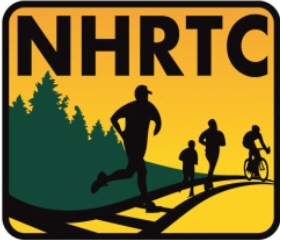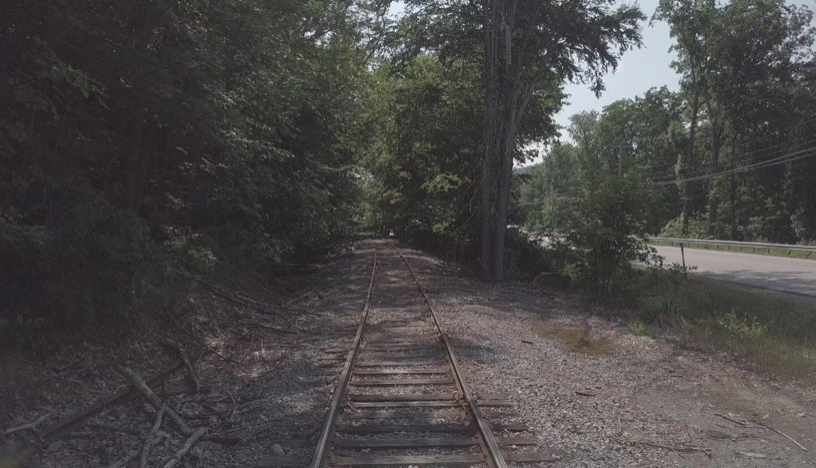
The Hillsborough Branch Rail line connecting Nashua and Wilton, NH presents an exciting opportunity to create an alternative transportation and recreation resource near the Route 101A corridor. This is a prime location for alternative transportation, with over 150,000 residents, and over 68,000 jobs located near this corridor. This active rail corridor is for sale and a proposal to purchase it has been made by CSX Transportation. This change of ownership is a window of opportunity to enhance this right of way with a multi-use trail concept: Rail-with-Trail (RWT).
Most recreational trail users are familiar with rail trails built on abandoned railroads, where the tracks are removed and smooth and level surfaces are laid down for riding bicycles, walking or horseback riding. But fewer trail users are familiar with trails coexisting with active rail lines, even though four examples of this kind of trail already exist in New Hampshire:
The first is the Cotton Valley Rail Trail between Wolfeboro and Wakefield, NH. The second is the Winnipesaukee River Trail in Tilton, NH and the third and fourth are the WOW and Winni trails from Belmont to Laconia, NH. Not all rail-with-trail concepts are the same, as these trails illustrate. The Cotton Valley RT is built on an inactive rail line, which is used by the Cotton Valley Railroad club to operate their “speeder” or “putt-putt” cars on the old rails. On this rail trail, the trail exists to the left, right and where the right of way is narrow, even in between the rails. This latter approach would break the rules for a rail-with trail for an active railroad, which follows the example of the WOW/Winni and Winnipesauke river trails: Here the rail trail is built alongside the rails, sometimes with a fence to enforce separation between the rails and the trail. This fence, while justified near higher use railroads, can be an expensive barrier to rails-with-trails, for lower use rail right-of-ways. A railroad with potential as a RWT generally falls into one of three categories: 1. Active, high-use. 2. Active, low-use, and 3. Inactive (potentially rail-banked).
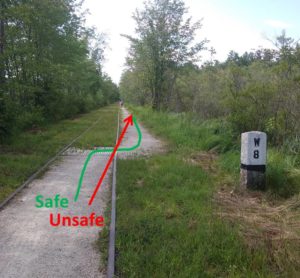
The Cotton Valley Rail Trail frequently crosses from between to outside the rails. It’s safest to stop and walk your bike across these rails to avoid a spill. If riding across them, slow down and ride straight across the rail at a right angle (green line) especially if the rails are wet.
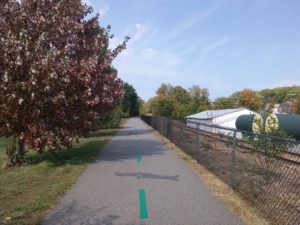
The WOW trail runs beside the railroad tracks, illustrating how they do not need to be removed to make a rail trail.
It could be likely that the Hillsborough Branch could be in category 2, or 3, so that a fence may not be required for RWT. This is possible because of the practice of protecting land-owners, including railroads, by Recreational Use Statutes, which are present in all 50 states, including “Live Free or Die” New Hampshire! In short, these statutes allow a landowner to allow recreational use on their property, either freely or by a lease to the state or local governments, without the landowner being liable for the injuries of anyone using the land. If in fact, the line is deemed inactive, and could be railbanked, then the rails could possibly be used for “rail bikes”, as are available on the rail line north of Concord, NH. Imagine a multi-use rail corridor supporting railbikes, bicycles, walkers and possibly even horses in areas where the right-of-way is wide enough!
I was recently surprised to discover during exploration of this right-of-way that this railroad already has some existing (albeit short) section of rail-with-trail. On Temple St. in Nashua, near Spruce street is a cross-walk and trailhead that leads northwest along the active rail line, toward the bridge over the Nashua River. There the bike/pedestrian path parallels the railroad, and crosses the bridge over the river to provide some excellent views up and downstream.
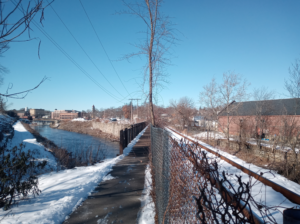
Section of rail-with-trail on the Hillsborough line in Nashua where the railroad and bike path cross the Nashua River.
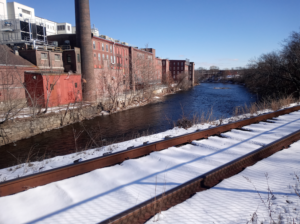
Looking east down the Nashua River from the bike/pedestrian bridge over the existing railroad.
The Friends of the Souhegan Valley Rail Trail is a grass-roots organization that is already working to explore how to obtain the rights to build a multi-use trail on this line. The group is currently not seeking to remove the rails, but instead to build a trail that could coexist with the railroad line and provide commuting alternatives as well as recreational use.
For more information check out this group on Facebook or the web at: https://souheganvalleyrailtrail.org/
You can also find more information about rail-with-trail on the Rails-to-Trails Conservancy website: https://www.railstotrails.org/build-trails/trail-building-toolbox/basics/rail-with-trail/
A recent (Jan 27th, 2021) webinar on the topic is posted here: https://www.railstotrails.org/build-trails/webinars/
